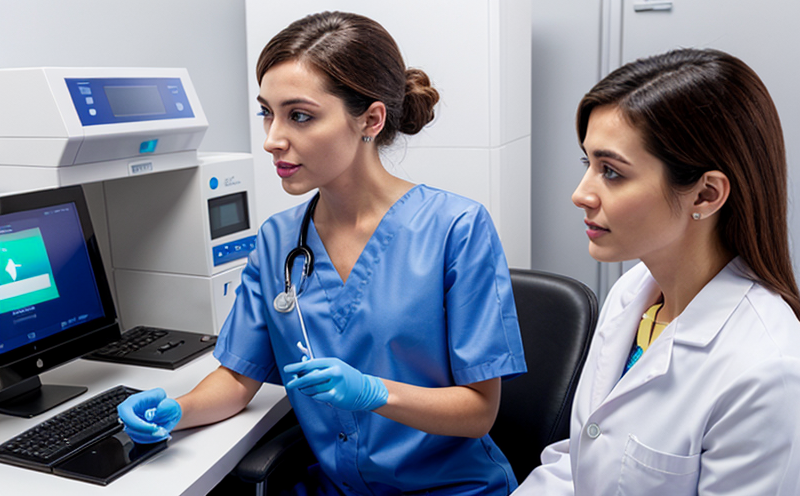DNA Sequencing for Microbial Strain Typing in Foodborne Outbreaks
DNA sequencing has become an indispensable tool in microbiology and food safety. In the context of foodborne outbreaks, accurate identification of microbial strains is crucial for effective outbreak management. This process involves characterizing microorganisms at a genetic level to distinguish between different isolates that might be responsible for contamination events within the food supply chain.
When dealing with foodborne illnesses, timely and precise typing can help in tracing the source of contamination, understanding transmission routes, and implementing targeted interventions. Traditional methods such as pulsed-field gel electrophoresis (PFGE) have been widely used; however, these techniques are time-consuming, labor-intensive, and often yield ambiguous results when comparing strains within a particular outbreak.
Enter DNA sequencing—a cutting-edge approach that offers unparalleled resolution for microbial strain typing. By examining specific regions of the genome, this technique allows for detailed differentiation between closely related isolates. This capability is particularly valuable in identifying subtle differences among pathogenic bacteria like Salmonella, E. coli, Listeria, and Campylobacter, which are often implicated in foodborne outbreaks.
The application of next-generation sequencing (NGS) technologies has further enhanced the utility of DNA sequencing for strain typing purposes. NGS platforms provide rapid data generation capable of processing multiple samples simultaneously. This not only speeds up the analysis process but also allows for comprehensive comparisons across large datasets, aiding in epidemiological studies.
Incorporating advanced bioinformatics tools alongside NGS facilitates robust analysis, making it easier to interpret complex genetic information and draw meaningful conclusions about outbreak origins. Furthermore, this approach supports more precise tracking of outbreaks, thereby enhancing public health response capabilities by enabling quicker identification of control measures necessary for mitigation efforts.
At our laboratory, we employ state-of-the-art sequencing technologies that ensure high accuracy and reliability in every project undertaken. Our experienced team oversees the entire process from sample collection to final report generation, ensuring compliance with international standards such as ISO 17025:2017. We strive to deliver comprehensive reports that include detailed descriptions of identified strains along with their epidemiological significance.
Our services extend beyond mere identification; we also offer support in interpreting results within broader public health frameworks, helping clients understand the implications of detected genetic markers for food safety and quality assurance practices.
Benefits
The adoption of DNA sequencing technology offers numerous advantages over traditional methods when it comes to microbial strain typing during foodborne outbreaks. One significant benefit lies in its ability to provide highly resolved data, allowing for better discrimination between closely related strains. This enhanced resolution enhances the accuracy and reliability of outbreak investigations, leading to more effective control strategies.
Another key advantage is speed. Unlike conventional methods which can take days or even weeks to produce results, DNA sequencing typically yields outcomes within hours to a few days depending on sample complexity and instrument capacity. Faster turnaround times translate into quicker identification of problematic products, reduced risk exposure periods for consumers, and more efficient resource allocation.
Moreover, NGS technology supports large-scale analyses, enabling simultaneous examination of multiple samples or isolates. This scalability is particularly beneficial in addressing multi-source outbreaks where numerous potential sources need to be evaluated concurrently. By leveraging parallel processing capabilities inherent to modern sequencers, laboratories can handle larger volumes of testing without compromising quality.
Additionally, the integration of bioinformatics pipelines with DNA sequencing enhances interpretability by automating data analysis processes and providing visual representations that simplify complex genetic data into actionable insights. These tools not only accelerate interpretation but also facilitate communication between technical experts and non-specialist stakeholders involved in outbreak management.
The use of standardized protocols and adherence to international standards like ISO 17025:2017 ensures consistent and reliable results across different laboratories worldwide. This standardization fosters trust among regulatory bodies, enhances collaboration between public health organizations, and promotes best practices within the industry.
Customer Impact and Satisfaction
The implementation of DNA sequencing for microbial strain typing in foodborne outbreaks has significantly impacted our clients by improving their ability to manage potential health risks associated with contaminated foods. By providing accurate and timely identification of pathogens, these services enable businesses to swiftly identify the root cause of contamination issues within their supply chains.
Our customers report increased confidence in their food safety programs following successful implementation of DNA sequencing technologies. They appreciate how this technology streamlines outbreak investigation processes, allowing for quicker responses that minimize consumer exposure and mitigate reputational damage. Furthermore, our comprehensive reports help them comply with regulatory requirements more effectively while fostering transparency between stakeholders.
We regularly receive positive feedback from satisfied customers who value the expertise of our team and the precision of our results. Many express appreciation for the insights gained into microbial behavior during outbreaks, which contribute towards enhancing overall food safety measures. Their satisfaction underscores our commitment to delivering high-quality service aligned with industry best practices.
International Acceptance and Recognition
DNA sequencing has received widespread acceptance among international regulatory bodies for its role in microbial strain typing during foodborne outbreaks. Organizations like the World Health Organization (WHO), Food and Agriculture Organization of the United Nations (FAO), and Centers for Disease Control and Prevention (CDC) recognize the value of this technology due to its ability to provide detailed genetic profiles that can differentiate between closely related strains.
ISO 17025:2017 standards emphasize proficiency in laboratory practices necessary for reliable DNA sequencing, ensuring quality assurance throughout all stages from sample preparation through final analysis. Compliance with these guidelines enhances confidence among stakeholders regarding the accuracy and consistency of results produced by accredited laboratories like ours.
Moreover, various international consortia and networks have embraced NGS-based approaches to enhance global food safety surveillance systems. Collaborations between countries facilitate sharing of data and best practices, contributing towards coordinated efforts aimed at reducing incidences of foodborne illnesses worldwide.





